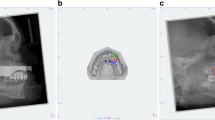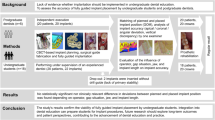Abstract
Aim
The aim of this study is to compare the surgical accuracy and efficiency of endo-osseous implant placement using a conventional method and when placed using a custom surgical guide.
Materials and methods
The study was carried out in a case control design on 20 patients aged between 15 years and 60 years. In the study group (n = 10) the implants were placed with the help of a surgical stent, while in the control group (n = 10) implants were placed in a conventional manner (without surgical stent) planned only with CBCT scan. The same surgeon placed the implants in both the groups.
Results
Each patient was considered in terms of the number of implants received. Each planned and actual implant was compared in terms of the 8 quantitative variables, which were used to observe and compare the accuracy of the surgical guides and conventionally placed implants. Data were analysed by a single blinded statistician using statistical software (Graphpad Prism (Version 5)). The Microsoft excel and Student T test for parametric data and Chi-square test for categorical data were used to observe significant differences between the 2 study groups. The nonparametric Chi-Square test revealed a statistically significant difference between surgical stent guided and conventional surgery in terms of buccal and lingual/palatal cortical plate to implant deviation, adjacent tooth to implant deviation, and mesiodistal angular deviation, whereas the differences between the marginal bone loss deviation, stability deviation, pain and swelling deviation, treatment time and number of sessions deviation, satisfaction deviation were not statistically significant.
Conclusion
From our study, we can conclude that guided surgery is essential for insertion of the implants regardless of the surgical technique. The success of the guided surgery depends on accuracy of the clinical and/or laboratorial steps of the virtual planning. Despite all the limitations and probability of errors encountered in our study, the guided surgery is superior in better positioning of implants.

















Similar content being viewed by others
References
Mark Haswell Dental implants: a different perspective Implant dentistry February 2009 Volume 2 Number1
Crabb C (2006) History of dental implants. Dent Nursing 2(8):398–399
Nickenig HJ, Eitner S (2007) Reliability of implant placement after virtual planning of implant positions using cone beam CT data and surgical (guide) templates. J Cranio-Maxillofac Surg 35(4–5):207–211
Almog DM, Benson BW, Wolfgang L, Frederiksen NL, Brooks SL (2006) Computerized tomography-based imaging and surgical guidance in oral implantology. J Oral Implantol 32(1):14–18
Garg AK (2006) Surgical templates in implant dentistry. Dent Implantol Update 17(6):41–44 (PMID: 16758934)
Milovanovic J (2007) Miroslav Trajanovic Medical applications of rapid prototy** 5(1):79–85
Engelman MJ, Sorensen JA, Moy P (1988) Optimum placement of osseointegrated implants. J Prosthet Dent 59(4):467–473
Lazzara RJ (1993) Effect of implant position on implant restoration design. J Esthetic Restorat Dent 5(6):265–269
Van Assche N, Van Steenberghe D, Guerrero ME, Hirsch E, Schutyser F, Quirynen M, Jacobs R (2007) Accuracy of implant placement based on pre-surgical planning of three-dimensional cone-beam images: a pilot study. J Clin Periodontol 34(9):816–821
Viegas VN, Dutra V, Pagnoncelli RM, De Oliveira MG (2010) Transference of virtual planning and planning over biomedical prototypes for dental implant placement using guided surgery. Clin Oral Implant Res 21(3):290–295
Schneider D, Marquardt P, Zwahlen M, Jung RE (2009) A systematic review on the accuracy and the clinical outcome of computer-guided template-based implant dentistry. Clin Oral Implant Res 20:73–86
Choi JY, Choi JH, Kim NK, Kim Y, Lee JK, Kim MK, Lee JH, Kim MJ (2002) Analysis of errors in medical rapid prototy** models. Int J Oral Maxillofac Surg 31(1):23–32
Pozzi A, Tallarico M, Marchetti M, Scarfò B, Esposito M (2014) Computer-guided versus free-hand placement of immediately loaded dental implants: 1-year post-loading results of a multicentre randomised controlled trial. Eur J Oral Implantol 7(3):229–242
Author information
Authors and Affiliations
Corresponding author
Ethics declarations
Conflict of interest
All authors declares no conflict of interest.
Additional information
Publisher's Note
Springer Nature remains neutral with regard to jurisdictional claims in published maps and institutional affiliations.
Rights and permissions
About this article
Cite this article
Sarkar, A., Hoda, M.M., Malick, R. et al. Surgical Stent Guided Versus Conventional Method of Implant Placement. J. Maxillofac. Oral Surg. 21, 580–589 (2022). https://doi.org/10.1007/s12663-022-01702-9
Received:
Accepted:
Published:
Issue Date:
DOI: https://doi.org/10.1007/s12663-022-01702-9




